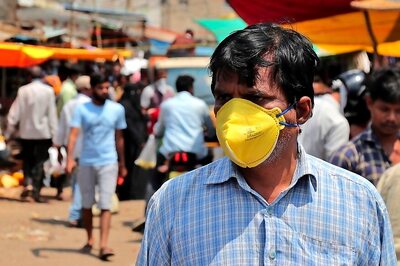
views
China is part of our nation’s near neighbourhood which makes its state and foreign policy behaviour quite pertinent to our state of the Union. The country’s vicious cycle of toying with the Indian border and the frontiers, as one may nomenclature the Line of Actual Control (LAC), has a familiar ring to it now. It’s not that the Chinese incursion in Galwan was an eye-opener of sorts for New Delhi’s diplomatic and defence establishment, myriad such transgressions have been witnessed since Depsang, Daulat Beg Oldie and the Sumdorong Chu incidents. The Merriam-Webster Dictionary delineates the threesome of incursions, transgressions and intrusions but apart from a simple foray or a patrolling exercise in the Indian territory, the theme of owning and annexing territory makes the intrusion an illegitimate one, as per the accepted norms and status quo ante at the contested borders.
An older treaty signed with the Chinese in 2012 attempted to contain the beacon forays by the patrolling units of both nations into each other’s territory. The present incursion in Arunachal Pradesh can be construed as a symbolic hegemonic messaging to the New Delhi dispensation as an aftermath of Cabinet Minister Rajnath Singh’s visit to Arunachal Pradesh. The American establishment, represented by President Joe Biden, has expressed satisfaction as the Indian and Chinese forces disengaged after the recent Tawang clashes. The existing bilateral channels can be utilised deftly to negotiate the conflicted boundary as both the national establishments construe the complete border quagmire. The Jammu and Kashmir Rifles, Jat Regiment and Sikh Light Infantry countered the Chinese transgressions as they attempted to change the status quo along the disputed border near the Yangtze River area.
Whenever Chinese transgressions occur, the nation comes under the dark shadow of the 1962 debacle. For every soldier martyred in the frozen heights of the Himalayas, the historic military debacle looms large over the spirit and the tenor of Sino-India relations. India has been a second mover while China has been very proactive in constructing critical infrastructure in the border terrain. India normally plays catch up but since the novae muscular approach in the nation’s foreign policy, the Chinese have been shown their place by a new nation on the upswing, both materially and symbolically. The Flintstone’s age makes a comeback with the recent Tawang incident which poses more than a question and poser at the hegemonic, arm-twisting and standout expansionist tenet of China’s foreign policy. The Indian contingent was obstructed by the Chinese equivalent at Finger 4 while patrolling in the Finger 8 region as far as the details of the Galwan valley intrusion are concerned.
Though the boundary standoffs and clashes leave a bad taste in the bilateral relations and flag meeting understanding and comprehension, several rounds of military and diplomatic talks have led to a semblance of disengagement and de-escalation, but the border chill remains again resurges to the forefront with the border conflagration in Tawang. The Chinese seemingly work on a revisionist and vendetta agenda which is sometimes hidden and sometimes overt. The Chinese lived through what they have named a century of humiliation, when they were harassed and exploited by the Western powers. The Chinese still harp about the historical wrong of the Shimla conference wherein Beijing’s representatives were not told all the facts of the treaty as the Britishers confabulated it. Thus, the idiom of the historical wrong serves as the running sore behind the border quagmire and thus, herein, lies the rationale behind the overtly aggressive approach of the Chinese vis-à-vis the boundary differences with New Delhi.
Normally, incidents have been witnessed on the border with China wherein the trespassing has been undertaken by platoon strength contingents, but the recent incident in Tawang witnessed around 600-odd Chinese uniformed men exchanging baton blows in stone age clashes with the Indian armed forces. Even during the Kargil war, the Chinese intruded into the territory India calls its own and thus, this is not the first time that the region has witnessed transgressions in areas earmarked as Indian. The Indian official-speak is that no Indian casualty occurred but the Indian forces had to obstruct the Chinese inroad as they were apparently making a strategic change to the status quo in the region. As the Indian political opposition was demanding a response from the government, Defence Minister Rajnath Singh said that India has given a befitting reply to the intruding Chinese People’s Liberation Army (PLA).
To hobnob with realism in international relations, the terrain of Arunachal Pradesh is the closest the Indian missile batteries get to the Chinese territory in the context of the border clash between the twin defence establishments. Thus, Tawang happens to attain geostrategic significance as far as the intruding intent of the Chinese is concerned. Also as an attendant fact, the Indian air defence batteries can be closely deployed in Arunachal Pradesh which causes more than heartburn in the Chinese strategic corridors and military planning. Also, the water wars are here to stay and they have always existed as a resident evil as the Tsangpo river originates in Tibet. In the year 2000, due to the breakage in an upstream dam, massive floods and damage occurred in the North Eastern region of India. All in all, one can contend and summarise that both nations have differing perceptions of the border in Arunachal Pradesh and both sides’ troops do more than fence-sitting as they commonly patrol their lines of claims.
Dr Manan Dwivedi is a Faculty, International Relations & International Organisations, at the Indian Institute of Public Administration; Shonit Nayan is a Research scholar. Views expressed are personal.
Read all the Latest Opinions here




















Comments
0 comment